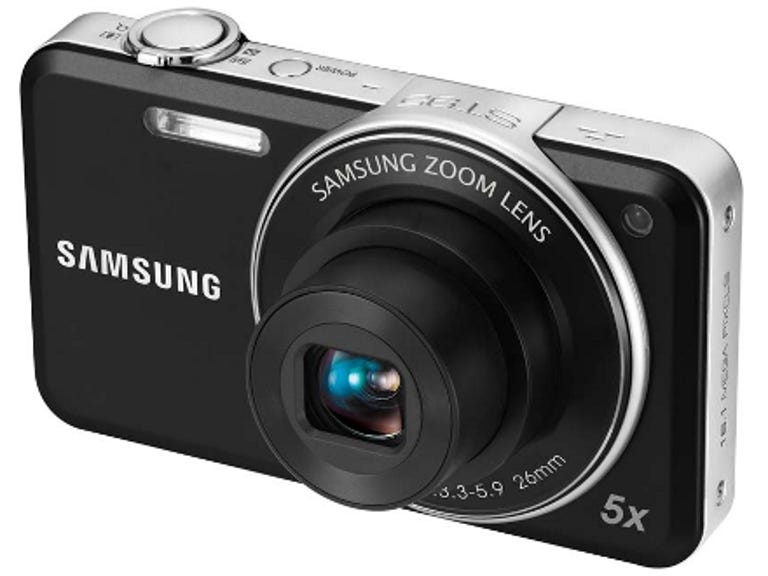 Why You Can Trust CNET
Why You Can Trust CNET Samsung ST95 review: Samsung ST95
The Samsung ST95 compact camera may be little, but it's big on features. It's also easy to use, has a good touch-based interface and comes at a very fair price.
Samsung's current camera range includes a number of highly pocketable models, including the ST95, which is just 17mm thick. At around £150 and sporting a resolution of 16.1 megapixels, the camera certainly offers a good megapixel-per-pound ratio. But what else is there to distinguish it from the competition?
The Good
The Bad
The Bottom Line
Thinner than thou
Despite its slender body, the ST95 has a decent set of specs and comes with most of the latest mod cons. The 16.1-megapixel sensor allows it to capture still photos at resolutions of up to 4,608x3,456 pixels, which is pretty much the top figure for compact cameras at the moment. The 5x optical zoom lens has a focal length of 26-130mm (35mm film equivalent), which isn't exceptional but offers a reasonable balance of wide angle and zoom reach.
The video mode records clips in 720p high definition, at 30 frames per second. You'll find cameras capable of higher quality than this elsewhere but, again, it's perfectly acceptable given the ST95's size and price. It's worth noting, though, that the ST95's mono-only microphone means your movies will have poor-quality audio. Additionally, the camera doesn't have an HDMI-out socket, so there's no easy way to play back your videos on your HD Ready TV.

On a related note, the only output socket available is a dual USB/AV port. It's a proprietary socket, which isn't necessarily a massive problem but could be annoying if you misplace the special cable and find that you can't use a regular one instead. Similarly, the camera stores images on microSD cards only. If you were hoping to re-use a standard-sized SD card from your old camera, think again.
Intelligence inside
The ST95 has a 'smart auto' mode that, like so many other similarly named equivalents from other manufacturers, aims to take the pain out of photography by gauging the situation independently -- close-up, landscape, night-time and so on -- and making all the appropriate adjustments for you, without you having to use either your brain or your fingers. Face-recognition, object-tracking and perfect-portrait modes make life simpler still.
Should you wish to experiment, however, you'll find that the ST95 offers a rather large selection of creative effects and tools so that you can get more from your photos. You can add stylish soft-focus, fish-eye or vignetting effects, for example. Samsung also includes a trendy miniaturisation effect, which reduces your subjects to tiny toy versions of themselves.
Access to these and other options is provided by an almost entirely button-free interface. A single home button brings up a set of icons on the 3-inch LCD touchscreen, each one representing a mode or effect that can be applied. Most effects have sliders that allow you to customise the results.
The screen responds to basic gestures, as well as taps, so you can scroll through lists with a flick of your finger, for example, or press and drag to use one of the sliders. It's a good system but it might take a while to get used to, particularly if you're not used to using a touchscreen phone. The display itself is of a fairly good quality, although the viewing angle makes it almost impossible to see what you're shooting when attempting overhead high-angle shots.
Overall, the picture quality is good for a camera of this price. Colours are bold and striking, with plenty of contrast and minimal purple fringing around the edges. Detail is good too, although, even in brightly lit situations, it can sometimes be lost to blur, which would suggest that the digital image stabiliser isn't doing its job properly. You may also notice some deformation around the edges of the frame, particularly at the wide angle.
Blur and noise are more of a problem in less well-lit locations. In fact, we weren't terribly impressed with our non-flash indoor test shots, despite the camera's high ISO sensitivity.
Conclusion
There are cheaper cameras available, but Samsung's ST95 does pretty well in the value stakes. Its movie quality may not be amazing but, in most other respects, the camera does better than you might expect, particularly when it comes to encouraging creativity.
The touchscreen is good too, but by far the best thing about the ST95 is its smart design. Unless you're wearing spray-on trousers, it'll feel comfortable in your pocket, because it's small, thin and light. That means you'll take it with you more often and capture more images as a result.
Edited by Charles Kloet


